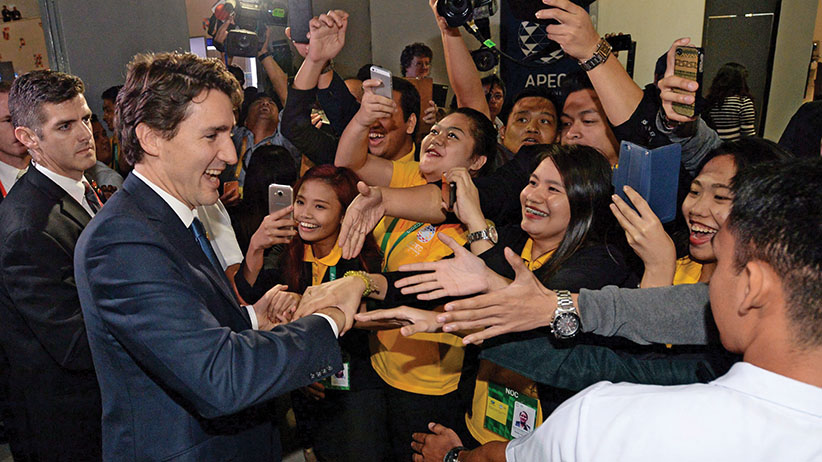What science says about the politics of sexy
Attractive politicians do better at the polls. Studies prove it. But there’s a downside.
Canadian Prime Minister Justin Trudeau is greeted by crowds of hysteria as he leaves his closing press conference following the APEC Summit in Manila, Philippines on Thursday, November 19, 2015. (Sean Kilpatrick/CP)
Share

With all the girlish shrieks and goofy hashtags, it can be hard to take Justin Trudeau’s now internationally certified hotness seriously. In Manila in November for the Asia-Pacific Economic Cooperation summit—a forum not previously known for scenes reminiscent of the stage exit at a boy band concert—the Prime Minister was mobbed by fans. They sought selfies and, just maybe, the touch of his hand. Trudeau took it in stride, remarking to reporters that, growing up as the son of an admired prime minister, he had to learn early “to set aside positive impressions that were not grounded in reality.”
It was the sensible response of a lifelong celebrity. Still, plenty of social science research shows that being physically attractive is a very real factor in a political life. So, even if Trudeau shrugs as the world ogles him, that doesn’t mean others can’t take a moment to ponder his appearance through the lens of scholarly detachment.
Studies leave little doubt that being easy on the eyes gives a politician an edge. For instance, researchers who looked at the 2010 British election found that being more physically attractive typically garnered a candidate two percentage points at the ballot box. That advantage held up, according to the study published earlier this year in The British Journal of Politics and International Relations, even when factors like age and campaign spending were taken into account.
In a 2012 study, German researchers assessed how 264 candidates fared in 49 mayoral elections. Each candidate’s attractiveness was rated on a one-to-six scale, based on photographs shown, with no other information, to 2,450 people participating online. For every one point rise on the scale, the study found the candidate’s share of the vote climbed on average by nearly three percentage points. The researchers delved deeper, exploring how other factors that might influence voter impressions—like age, marital status and immigration background—work in combination with physical attractiveness. When these “control variables” were taken into account, the paper, published in German Politics, concluded the effect of physical attractiveness isn’t less pronounced, it actually “increases considerably.”
Anyone who has watched Trudeau’s ascent, though, might raise an objection. His conspicuous good looks, while clearly appealing to some, make others doubt his seriousness. Victor Ottati, a psychology professor at Loyola University in Chicago, has studied the way some leery voters view more handsome candidates. “You tend to get the traditional finding that the candidate is liked more if he’s attractive . . . among people who are relatively low in political knowledge,” Ottati said in an interview. “Whereas, interestingly, people who are high in political knowledge bend over backwards to not allow appearance to bias their evaluation of the candidate.”
In one of Ottati’s experiments, college volunteers spent nine minutes reading a short description of a fictional political candidate. Either an attractive or unattractive photo of the made-up politician was attached to the written material. Overall, looking better gave the candidates an advantage in how volunteers rated them. But when Ottati gave the volunteers a test to assess their political knowledge, he found the more sophisticated participants were on guard against overrating a good-looking pol. “In some cases, they will in fact over-correct,” he said. “They are trying to be so diligent in not favouring the attractive candidate that they start to reveal the reverse bias in some cases.”
Intriguing as they are, these studies have limitations. Most tend to examine early impressions, rather than the evolution of a political persona over time. And time matters. In advertising, the Conservatives tried to link Trudeau’s looks, especially his “nice hair,” to the message that he wasn’t ready to lead. But pollster Greg Lyle, of Innovative Research, said his firm’s testing of the Conservatives’ widely seen “job application” TV ad shows it worked well only before the election, then “ran out of gas” during the campaign itself. It seems even voters who started out wary of Trudeau’s coif grew curious, as the campaign wore on, about what was going on underneath it.